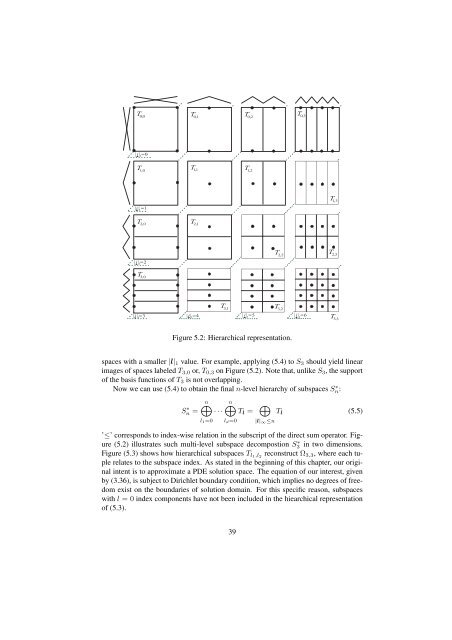sparse grid method in the libor market model. option valuation and the
sparse grid method in the libor market model. option valuation and the
sparse grid method in the libor market model. option valuation and the
You also want an ePaper? Increase the reach of your titles
YUMPU automatically turns print PDFs into web optimized ePapers that Google loves.
T<br />
0 , 0<br />
T<br />
0 , 1<br />
T<br />
0 , 2<br />
T<br />
0 , 3<br />
|i|<br />
1 = 0<br />
T<br />
1 ,0<br />
T<br />
1 , 1<br />
T<br />
1 ,2<br />
· · ·<br />
|i|<br />
1<br />
= 1<br />
T<br />
1 ,3<br />
T<br />
2 ,0<br />
T<br />
2 , 1<br />
·<br />
·<br />
T<br />
2 ,2<br />
T<br />
2 , 3<br />
|i|<br />
1 = 2<br />
T<br />
3 ,0<br />
|i|<br />
1 = 3<br />
|i|<br />
1 = 4<br />
T<br />
3 , 1<br />
|i|<br />
1<br />
= 5<br />
T<br />
3 ,2<br />
|i|<br />
1<br />
= 6<br />
T<br />
3 , 3<br />
Figure 5.2: Hierarchical representation.<br />
spaces with a smaller |l| 1 value. For example, apply<strong>in</strong>g (5.4) to S 3 should yield l<strong>in</strong>ear<br />
images of spaces labeled T 3,0 or, T 0,3 on Figure (5.2). Note that, unlike S 3 , <strong>the</strong> support<br />
of <strong>the</strong> basis functions of T 3 is not overlapp<strong>in</strong>g.<br />
Now we can use (5.4) to obta<strong>in</strong> <strong>the</strong> f<strong>in</strong>al n-level hierarchy of subspaces S ∗ n:<br />
S ∗ n =<br />
n⊕<br />
· · ·<br />
l 1=0<br />
n⊕<br />
T l =<br />
l d =0<br />
⊕<br />
|l| ∞ ≤n<br />
T l (5.5)<br />
’≤’ corresponds to <strong>in</strong>dex-wise relation <strong>in</strong> <strong>the</strong> subscript of <strong>the</strong> direct sum operator. Figure<br />
(5.2) illustrates such multi-level subspace decompostion S3 ∗ <strong>in</strong> two dimensions.<br />
Figure (5.3) shows how hierarchical subspaces T l1,l 2<br />
reconstruct Ω 3,3 , where each tuple<br />
relates to <strong>the</strong> subspace <strong>in</strong>dex. As stated <strong>in</strong> <strong>the</strong> beg<strong>in</strong>n<strong>in</strong>g of this chapter, our orig<strong>in</strong>al<br />
<strong>in</strong>tent is to approximate a PDE solution space. The equation of our <strong>in</strong>terest, given<br />
by (3.36), is subject to Dirichlet boundary condition, which implies no degrees of freedom<br />
exist on <strong>the</strong> boundaries of solution doma<strong>in</strong>. For this specific reason, subspaces<br />
with l = 0 <strong>in</strong>dex components have not been <strong>in</strong>cluded <strong>in</strong> <strong>the</strong> hiearchical representation<br />
of (5.3).<br />
39
















